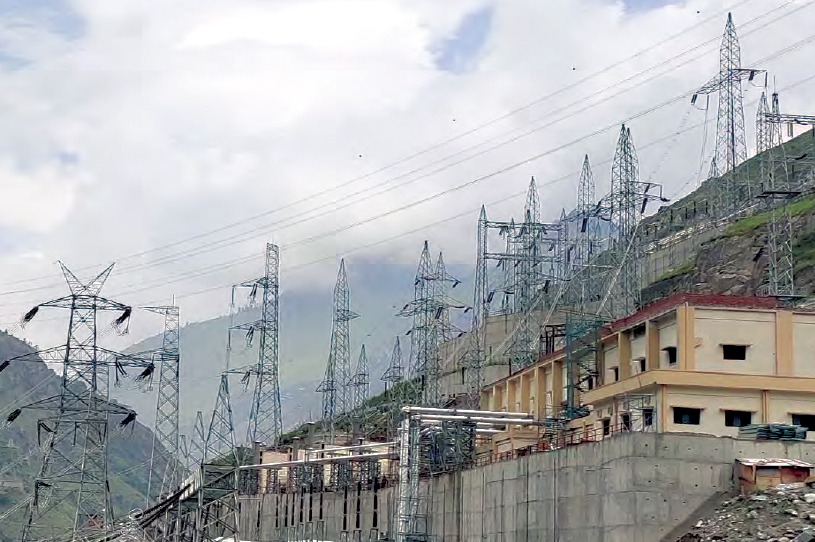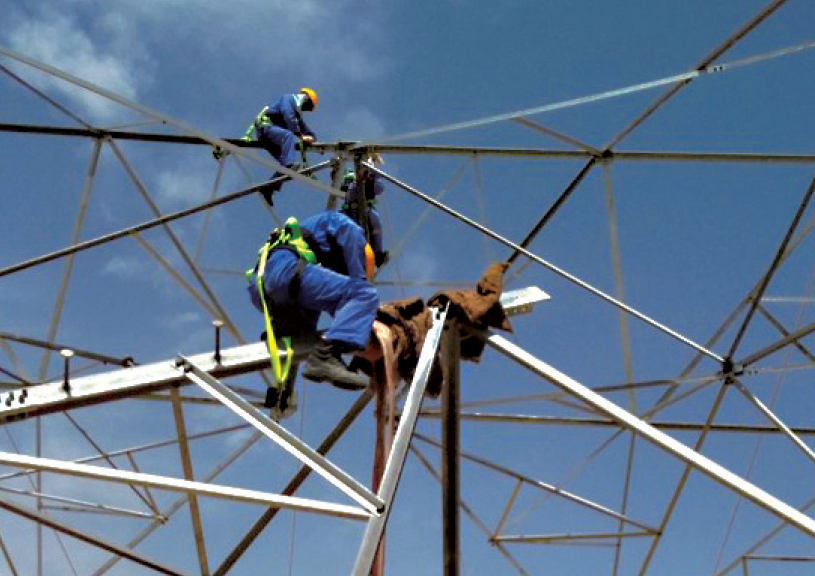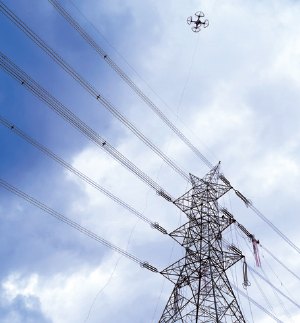
T Madhavadas,
Senior Vice President & Head (Power Transmission & Distribution)
The colour of a person’s helmet at any of our jobsites may be white, blue, green or yellow; but the blood that runs in all of us is red. Safe behaviour is therefore a shared imperative irrespective of cultural backgrounds, positions in hierarchy, personal beliefs, urgency of the task, constraints, limitations, etc. There is no way of undoing a loss and there’s no such thing as right amount of compensation.
Behaviour modification, beyond awareness creation, is essential. Technology can be leveraged to make such training more effective. That is why we use immersive Virtual Reality modules and gamified microlearning apps. Perhaps we are the only EPC player in T&D space to do so with such scale and minutiae. Given the big churn the subcontractor labour pool undergoes these days, we must be extra careful in imparting training to each and every one of the newly joined workers. A construction site is an edifice of labour, effective demonstration of leadership by site staff, interplay of engineering disciplines, actualization of meticulous plans and unfolding of a vision – undoubtedly not a death trap. This is what we endeavour to demonstrate always!

EXPLORING NEW HORIZONS; CONQUERING EVERY TERRAIN
Understanding how the challenges of different terrains are met
As the ‘Columbus’ of L&T Construction, the Power Transmission & Distribution IC has the unique distinction of exploring a cross-section of terrains, both at home and overseas. Be it stringing the 220 kV Alusten-Drass Transmission Line across Jammu’s predominately snow-clad regions or constructing the 400 kV GIS at Wangtu, Himachal Pradesh; bringing light to 226 villages in Bihar as part of India’s largest rural electrification project or braving the deserts of Oman to build the 400 kV Izki transmission line or even venturing into the dark continent to construct the 500 kV HVDC EthiopiaKenya interconnect, Africa’s largest, PT&D has been redefining the rules of project execution. It is equally commendable how the IC has strategized to effectively mitigate execution risks across varied and challenging terrains while consistently raising the safety bar.

400 kV Wangtu Substation
Higher the altitude, greater the challenge
Apart from hydro power projects, transmission and distribution jobs constitute a major portion of L&T’s high-altitude sites. At any given point of time, PT&D would be executing projects across the upper reaches of India like the Karcham- Wangtu Abduallpur line.

A view of snow clad terrain around the Wangtu Substation
For Atul Singhal, Project Manager and team at the Wangtu Substation, the stakes were always high while executing one of India’s highest located gas insulated substations at an altitude of + 2000 m above mean sea level. “Apart from the varying hilly terrain, there were a range of critical factors to be addressed such as working in freezing temperatures, safe movement of bulk equipment across the ghat roads, hard rock excavation, construction of RCC retaining walls, and of course, being prepared for the unexpected natural calamities,” shares Sr. Planning Manager, K. Sivakumar.

An inside view of the Wangtu GIS
At the 220kV S/c Alusteng-Drass (PartII) Transmission Line, the challenge for Project Manager Subash Chander Sharma, and team was larger as the 50 km section passed through the DrassGumri-Zoji-La pass which is normally closed for more than six months in a year due to avalanches, massive snowfalls with snow accumulating to as high as 5 to 6 m. “Route finalization was of utmost importance,” highlights Subash, “the survey was undertaken by the National Remote Sensing Agency and approved by the Snow and Avalanche Study Establishment after a thorough review with critical recommendations for the alignment. Further, we segregated the areas into sections and worked with consultant teams to arrive at the most feasible and safest route.”

Virtual Reality training for workmen
Weathering the adverse weather
Unlike several of the well-defined construction projects, power transmission and distribution projects are vast spanning, at times, even crosscountry that calls for detailed risk assessment of the weather conditions and varied terrains. PT&D has been largely successful in formulating control measures for specific natural events especially for projects across hilly and arid zones.
Both at the Wangtu substation and Alusteng–Drass transmission line projects, the working hours were realigned with the prevailing conditions. “We categorised the various tasks going by the risk index matrix as critical, high, medium and low and scheduled the activities accordingly. Work started as early as 6.45 am to overcome the threat of rain and low light. The teams were provided adequate warm clothing and safety essentials. In critical tasks where more thrust was required, customized safe methods were devised to make the entire exercise secure,” shares Atul.

Safety messaging for public during the movement of hulking transformers
Citing a typical turbulent phase at site, Atul sighs, “On 27th May 2017, there was a severe hail storm followed by a cloud burst at around 5 pm but timely alerts ensured that the entire team and the workmen gangs were moved from the site to a safer place via a temporary exit. The damage caused to structures and material was extensive, but not a single life was lost. Together, we achieved more than 3 million safe-man hours.” Atul’s sense of achievement is apparent.

A section of the Alusteng–Drass transmission line across snow-clad slopes
With the working season limited to only between mid-June to Octoberend, the project team at Alusteng–Drass had to hit the ground running. “With close to 164 locations earmarked for civil works along with construction of temporary bridges and access ways, in addition to special foundation works, it was a tough task that had to done with utmost safety,” asserts Subash. “The focus was on providing workmen with amenities such as special shoes along with adequate winter clothing, with appropriate temporary facilities like tents and sheds along the alignment. Further, a range of special monitoring tools were deployed to gauge adverse weather conditions to alert the working crew.”
Similarly, for international projects adequate control measures are implemented such as procuring specific PPEs to protect workmen from the extreme weather. To mitigate risks, emergency plans are darwn up, and mock runs familiarize teams to safe response during any crisis. In addition, separate EHS advisories relevant to the hazards across specific terrains are released on a timely basis and workmen are briefed on how to safeguard themselves from wild animal attacks, climb steep hills and overcome lack of oxygen at higher altitudes.
“The survey was undertaken by the National Remote Sensing Agency and approved by the Snow and Avalanche Study Establishment after a thorough review with critical recommendations.”
– Subash Chander Sharma
Project Manager, 220kV S/c Alusteng-Drass TL
Keeping a safe distance
Working as a team is something L&T-ites excel at, and at remote locations, this is critical especially when the alignment is close to a forest. “We advocate workman gangs to move only in groups to face and overcome the threat of wild animals while our EHS coordinates had dedicated people to keep vigil and prompt alerts,” mentions Subash.
With the ever-present threat of wild animals in the ongoing transmission line projects in Botswana, game wardens have been roped in for extra vigil and accompany construction teams in specific areas where wildlife activity is more. Routes are inspected with drones wherever accessibility is a challenge. Local EHS professionals with comprehensive insights on their country’s specific requirements have been brought on board to assist teams to implement and enforce legislative requirements.

Rock breaker deployed for breaking hard rock
Establishing firm footings
Transmission and distribution projects are all about integrating the structural elements by establishing firm footings across various terrains where excavation is a challenge either because of limited approach ways and/or varying soil strata of mostly dry fissured or hard rock. It is interesting that project teams vouch for controlled blasting as a safe method to make headway. “Of course, this is a critical task,” highlights Atul but he reaffirms, “With close to 3 lakh cu.m of excavation of which 50% was hard rock, we ensured a combination of safe blasting methods that included chemical cracking and diamond cutting backed by a 4-tier safety scheme comprising blasting mats, alarm and flagging systems with appropriate road closures.”

Establishing firm footings
The level of precision required to arrive at the exact foundation requirements for towers is a key factor before scaling up the steely elements, shares Subash “At the Alusteng – Drass project, we had to align with the distinct tower foundations designed by the Snow and Avalanche Study Establishment to withstand the extremities of the region. Grade ‘C’ steel was used in the tower elements and hardware fittings to withstand the extreme cold temperature. It is worthwhile to mention that, “We used an admixture for quick setting of concrete while for special foundations, self-load transit mixers with boom pressure was used for concrete pouring in avalanche prone areas that significantly increased our productivity and reduced time,” he adds. While accessibility is an issue across the ghats, terrains in arid zones across the Middle East and Africa have their own share of ground engineering issues to resolve. The 400 kV IzkiIbri OHL across a span of 265 km had a safe strategy in place, assures S. Ayappan Project Manager, giving an insight on the scope: 645 towers spread across varying terrains with a total excavation scope of 1,28,000 cu.m, concrete quantity of 18,100 cu.m and 1700 t of steel rebar works. “Depending on the ground profile, most of the towers were configured aligning to deviations as per actual soil parameters against the norm of fixed parameters that considerably reduced foundation volumes. Further, at the initial stage itself, each tower was marked and inspected, and risky locations and watercourses avoided.”
“With close to 3 lakh cu.m of excavation of which 50% was hard rock, we ensured a combination of safe blasting methods.”
– Atul Singhal
Project Manager, Wangtu Substation
Engineering safe passage ways
The ghats are always challenging and more so when transporting heavy equipment such as transformers and transmission line tower elements. At the Wangtu substation site, our Special Projects and Construction Methods team stepped in to provide the required know-how to move 9 hulking transformers, two of them weighing 122 MT each and the other 7 weighing 80 MT each across the Solding Khad and Jaypee Bailey Bridges. The challenge was to negotiate the critical stretches as the bridges are the only link to Kinnaur and Lahal Spiti Districts and extremely important for army movement to the border areas.

Workmen on lifelines to raise the steely tower members
“We carried out a thorough analysis of the bridge and developed a customized solution by reducing the self-weight of the system (without puller and trailers) and pulled it using a skid system. To meet the bridge design requirements, the lattice girder system configuration was devised as an easy assembly and dismantlable pin connection,” shares Sivakumar. “The transportation system was reconfigured with variable load distribution and simulated to reciprocate with the IRC Standard of the vehicle to enable transportation without any need to either strengthen or modify the existing bridge.”

Safely moving a hulking transformer across an old bridge
The site had its own share of learnings, admits Sivakumar, “In total, there were 24 near mises but then, we had the right back-up to ensure that things did not go out of hand.” Today, the Wangtu site is a repository of EHS benchmarks that is a ready reckoner to execute for high altitude power infrastructure jobs.
“We carried out a thorough analysis of the bridge and developed a customized solution by reducing the self-weight of the system (without puller and trailers) and pulled it using a skid system.”
– K. Sivakumar
Sr. Planning Manager, Wangtu Substation

Configuring a safe method for moving a heavy weight transformer
Raising towers safely
You may be skilled, bold and raring to go but scaling heights is akin to mountaineering, remarks Ayyappan, and cautions, “You don’t get a second chance and thus it was mandatory to close all gaps with double linear rope fall arrestors that made all the difference.” Lifeline ropes were further secured with a rope grab fall arrestor to ascend and descend along with a positioning belt. This meant a workman would not fall! This was planned across the 200 plus span in case of any unlikely incident backed by the “Provision of an emergency rescue kit with trained rescue teams stationed at each height work location.” At intermediate points of 20 km, there were mobile units that could reach the locations swiftly.
“Double linear rope fall arrestors that made all the difference. Lifeline ropes were further secured with a rope grab fall arrestor to ascend and descend along with a positioning belt.”
– S. Ayyappan
Project Manager, Izki TL
To make working at heights safer with 360-degree monitoring, a unique buddy system was implemented by making one person responsible for a group of 8 workmen. “It is a simple bonding scheme that worked very well as each gang had a monitor who was placed outside the scope of work to look into details like weather conditions and inform the crew about any adversities.” Additionally, a safety work log was maintained for linemen so that none of the team worked at a stretch for more than 4 hours or climbed more than 3 times a day. This initiative significantly addressed work stress and fatigue levels of the crew while, at the same time, created a safe work environment.

Scaling heights with secure rope grab fall arrestors
For the snow-clad terrain in Alusteng – Drass Transmission Line, the team came up with some timely process enhancements to facilitate tower erection. “Motorized 5 t winches were used across accessible areas to lift the tower parts while special plateena rope was used to pull the conductor through winches due to its light weight and ease of handling in hilly terrains. Further, S-rollers were deployed for crossing steep hills and deep valleys,” mentions Atul.

Scaling heights with secure rope grab fall arrestors
Being cautious at crossovers
Scheduling power corridor crossings are always critical as it largely depends on the status of Permit To Work (PTW) and calls for stringent safety measures. At the Izki transmission line, there were 3 EHV cross overs and two underground lines that had to be mitigated. Meticulous paperwork aligning to the distribution requirements of the existing grids were prepared. “One of the crossings was a high-density power corridor where closure was not possible,” shares Ayyappan. “We therefore had to opt for a complex bifurcation plan of securing one of the outages while the other circuit was shut down for the cross over works.” Stringing works were done with a 16-t puller and tensioner covering 9 km of pulling across a single section while the final sagging was done using sag bridges.

A strategic power corridor with crossovers

Strategic power line crossovers with drones

The 500 kV Yong Peng East Substation to Point A Transmission Line in Malaysia is another example of how critical crossovers were safely executed over existing 275 kV and 132 kV lines aligning to the standard operating procedures. Apart from the hotline crossings, other critical crossovers include railway lines, highways and water bodies that called for a cautious PTW approach within VOICES FROM “Today, the IC, has developed unique SOPs for safe execution of every task while digitalization has given the much-needed edge through Virtual Reality (VR) training programmes as workmen are made to realise the risks and reinforce the essence of safe working.” V. Ramanathan Head-EHS, PT&D a limited window for working. At the Kudgi transmission line project in Karnataka, the team successfully enabled crossovers across strategic sections with the help of drones, an interesting and safe execution strategy involving highlevel D-electric 16 mm Plateena rope tied to the drone and guided over to the new tower location where it is fixed by a fitter while maintaining minimum sag at the desired locations.
“Today, the IC, has developed unique SOPs for safe execution of every task while digitalization has given the much-needed edge through Virtual Reality (VR) training programmes as orkmen are made to realise the risks and reinforce the essence of safe working.”
– V. Ramanathan
Head-EHS, PT&D
Prepping up safely for a quantum leap
In its continuing effort to power nations, PT&D has the onus of being a safe player across geographies and terrains a task that it has addressed comprehensively through orientation and skill based training programmes both for employees and workmen at site. “Today, the IC, has developed unique SOPs for safe execution of every task while digitalization has given the much-needed edge through Virtual Reality (VR) training programmes as workmen are made to realise the risks and reinforce the essence of safe working,” says, V. Ramanathan, HeadEHS. Certainly, for PT&D, it is all about raising the safety bar time and again as they go about accomplishing powerful landmarks.




